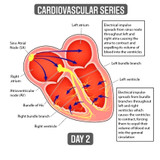Cardio Series

Reposted from @archangeltacmed The conduction system.
The heart muscle is made up of special muscle called myocardium. These muscles have the ability to conduct and produce movement on their own. Meaning they don't need the nervous system telling them to work. I'm not going to go into the cellular level here but you can dive even deeper into this if you wish with a simple internet search.
If you watched the videos on the post yesterday you saw a normal beating heart start in the Atrium and then move to the ventricles. With each portion of the beat, blood is flowing continuously through the heart and body. Each movement allows blood to move out and circle back. Based on where the heart beat originates in the heart (atria vs ventricles) dictates if it will be a perfusing beat. You can usually tell where it originates in the heart based on the speed. (In a relaxed patient who's not bleeding out)
With a heart rate of 60 to 100 it originates at the SA Node in the Atrium. This is considerd normal
If its 40 to 60, , the beat is originating at the AV node which is located at the bottom of the right atrium.
If the rate is less than 40 its considerd a ventricular rate and this is bad. The heart is not perfusing properly. This patient needs immediate intervention.
Think of the AV Node as the back up when the SA Node isn't working, and the ventricles (purkinje fibers) as the last line of defense before the beating has no place to originate from.
Besids rate, quality is key. If you take someone's pulse, feel for 10 to 15 seconds. In that time you can tell if it feels regular or irregular. An irregular pulse may not profuse correctly and can lead to blood clots as well as heart attacks and stress on the heart.
Why am I talking about this? It's to bring awareness so you understand the How of the heart. This is quick and easy. There's alot more we can add and go deeper but I'd like everyone who reads this to understand it.
As always seek out an anatomy class to learn more about the heart, or khan academy medicine on youtube. These videos have helped thousands of doctors nurses and medics learn the inner workings of the heart.
